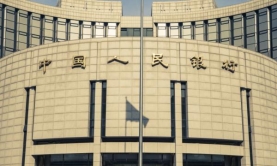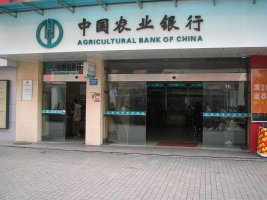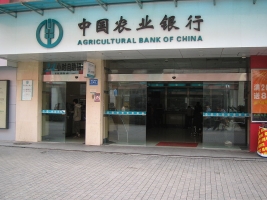China
China's first bank seizure in decades highlights growing small bank risk
State-owned CCB will ba taking over the business of Baoshang Bank.
China's first bank seizure in decades highlights growing small bank risk
State-owned CCB will ba taking over the business of Baoshang Bank.
Citi names Luke Lu as Citi China Commercial Bank head
He was previously the head of global corporate banking at MUFG Bank China.
Chinese regulators to take over regional lender Baoshang Bank
The regulators identified serious credit risks.
HSBC to add over 1,000 China tech jobs
It will boost headcount at Guangzhou, Shanghai and Xi'an by 14% from the current 7,000.
Bank of Communications unveils branch in Prague
The latest opening marks its 23rd overseas unit.
Chart of the Week: Global ATM numbers drop for first time as China, India and Japan shun cash
The growing popularity of mobile payments is partially to blame.
Credit Suisse sets up family office unit in China
The Swiss lender named Tan Mae Shen as senior specialist for family office services in APAC.
Chinese banks stem lending in April as debt worries rise
Banks extended $150.16b in net new yuan loans.
Banks caught in Beijing's risky balancing act as second largest economy stutters
The People’s Bank of China has launched a Central Bank Bill Swap to help banks actively lend more. Two months after the world’s second-largest economy posted its slowest growth pace since 1990, Beijing has stepped up its support for the banking sector, highlighting its key role in the government’s plan to sustain the pace of expansion. However, smaller banks will likely face a trying 2019 despite the slew of measures meant to expand capital access and bolster profits. Unlike the goliaths of the banking sector, smaller banks will feel the squeeze on all sides, from the aftershock of the government’s deleveraging drive to the current push to boost lending as a way to support the slowing economy. Larger state-owned banks are relatively more insulated from the current industry pressures compared to smaller private banks, which are more exposed in terms of weaker loan quality, funding concerns and diminished access to both internal and external capital, according to Andrew Wong, vice president, credit research at OCBC, as they enjoy better access to higher-quality borrowers and a robust funding stream via deposit franchises and capital market access. China’s economy grew at a slower annual pace of 6.6% in 2018 and Beijing has targeted a more modest expansion of between 6-6.5% in 2019 amidst a turbulent geopolitical backdrop marked by trade tensions with the US With the decelerating economy weakening the ability of businesses to repay debt, the NPL ratio of Chinese commercial banks climbed to a 10-year high of 1.89%, said Liu Zhiqing, deputy head of the statistics department of the China Banking and Insurance Regulatory Commission (CBIRC), according to a Reuters report. “Banks will need to remain alert to these dynamics too and monitor their risk profile through stringent underwriting,” added Wong. “Higher-than-expected loan losses will be more detrimental to earnings and capital generation in this slower growth and tighter funding environment.” Banks will also need to make full use of the perpetual bond issuance policies and other measures that may be rolled out in a bid to ease capital constraint, he said. In January, the People’s Bank of China launched Central Bank Bills Swap (CBS) to support perpetual bond issuance, which the central bank reckoned will help banks replenish their capital and be in a stronger position to support the broader economy through their lending operations. “We see the action is credit-positive for banks’ depositors and senior debt holders because the swap facility will increase the attractiveness of bank-issued perpetual bonds to participating investors and support banks’ efforts to strengthen capital,” said Ray Heung, senior vice present at Moody’s Investors Service. The CBS scheme functions as a policy aid for banks to achieve the ambitious administrative target on lending to the private sector and expand their balance sheets accordingly, said Alicia Garcia Herrero, chief economist at Natixis.
China cuts small banks' RRR to 8% in funding boost for credit-starved firms
The latest cut will unleash around $41.23b in long-term funding.
China relaxes ownership regulations further in financial opening
Billion-dollar asset requirements have been removed.
Chinese megabanks hit ‘modest' profit growth in Q1
New loans reached a record amount of $862.89b.
Chinese banks' assets up 7.7% to $33.9t in March
Total liabilities rose 7.3% to $36.63t.
Chinese banks' small business loans up 17% in Q1 as stimulus kicks in
Banks achieved 55% of their annual targets for small companies.
Chinese banks' struggling bottomlines aggravates capital crunch
The growth of risk-weighted-assets continues to outpace conventional assets.
ICBC names Chen Siqing as chairman: report
Chen has served as Bank of China’s chairman since August 2017. The world’s largest bank by assets, Industrial & Commercial Bank of China (ICBC) has reportedly tapped Bank of China (BoC) chairman Chen Siqing as its new head, sources told Reuters. The new chairman, who headed BoC since August 2017, will have to steady ICBC’s profitability as the Chinese economy slows, threatening a spike in bad loans. In October-December, ICBC saw no quarterly profit growth for the first time since 2016. The appointment is still pending regulatory, shareholder and board approvals, said one of the sources. The last ICBC chairman, Yi Huiman, was appointed as the head of China Securities Regulatory Commission. Here’s more from Reuters.
New licensing rules may wipe out P2P lending in China
Stricter requirements may leave just 100 surviving players out of over 1,000.












 Advertise
Advertise


















